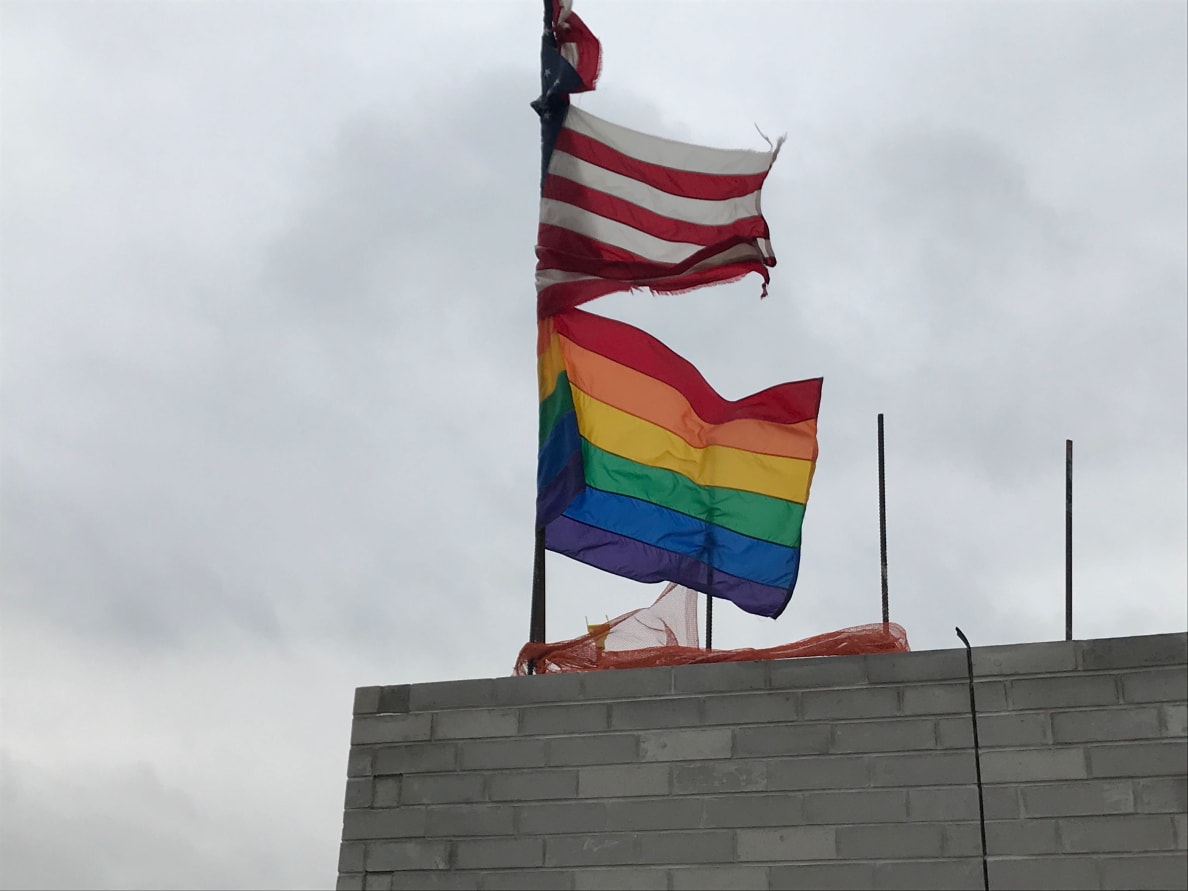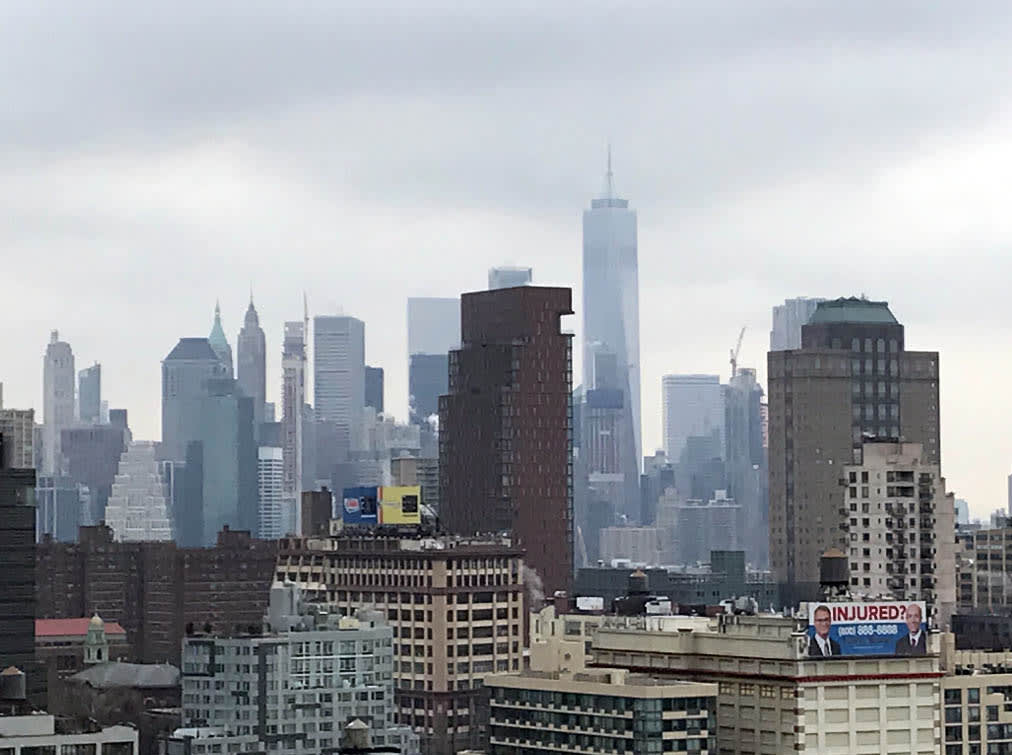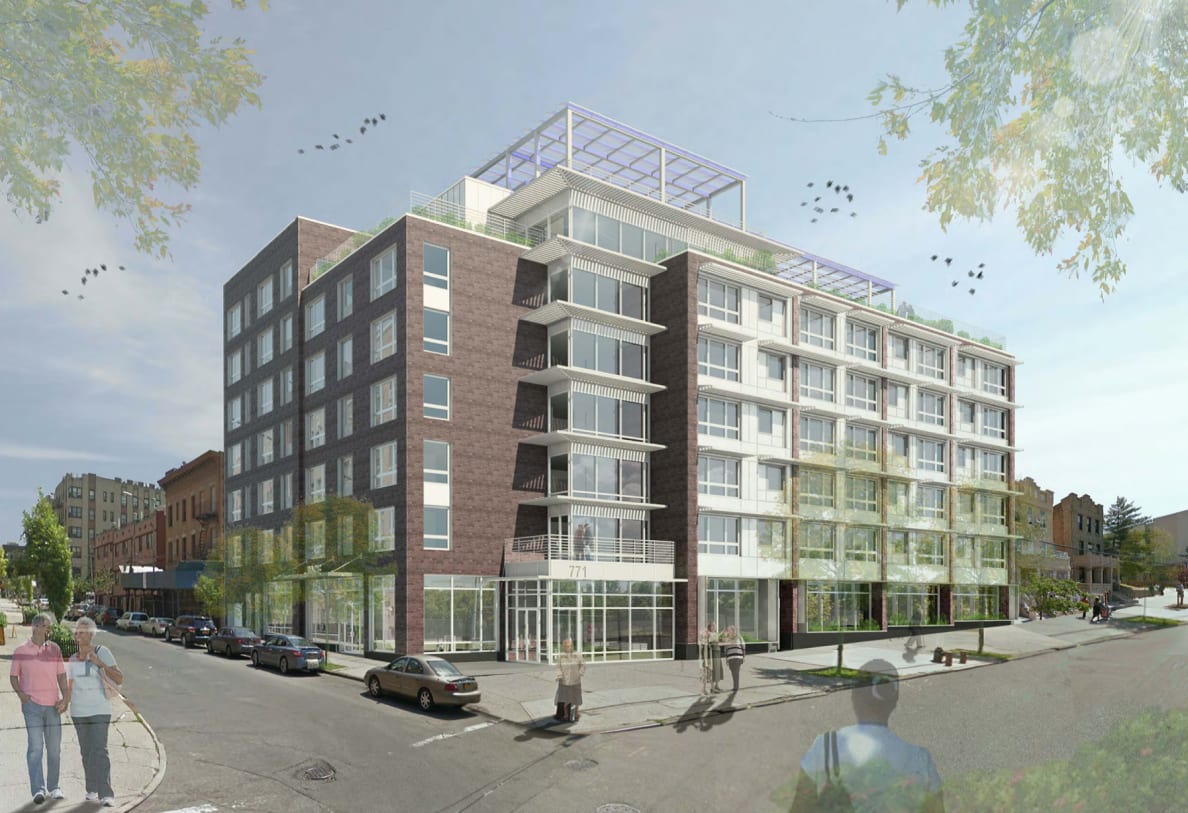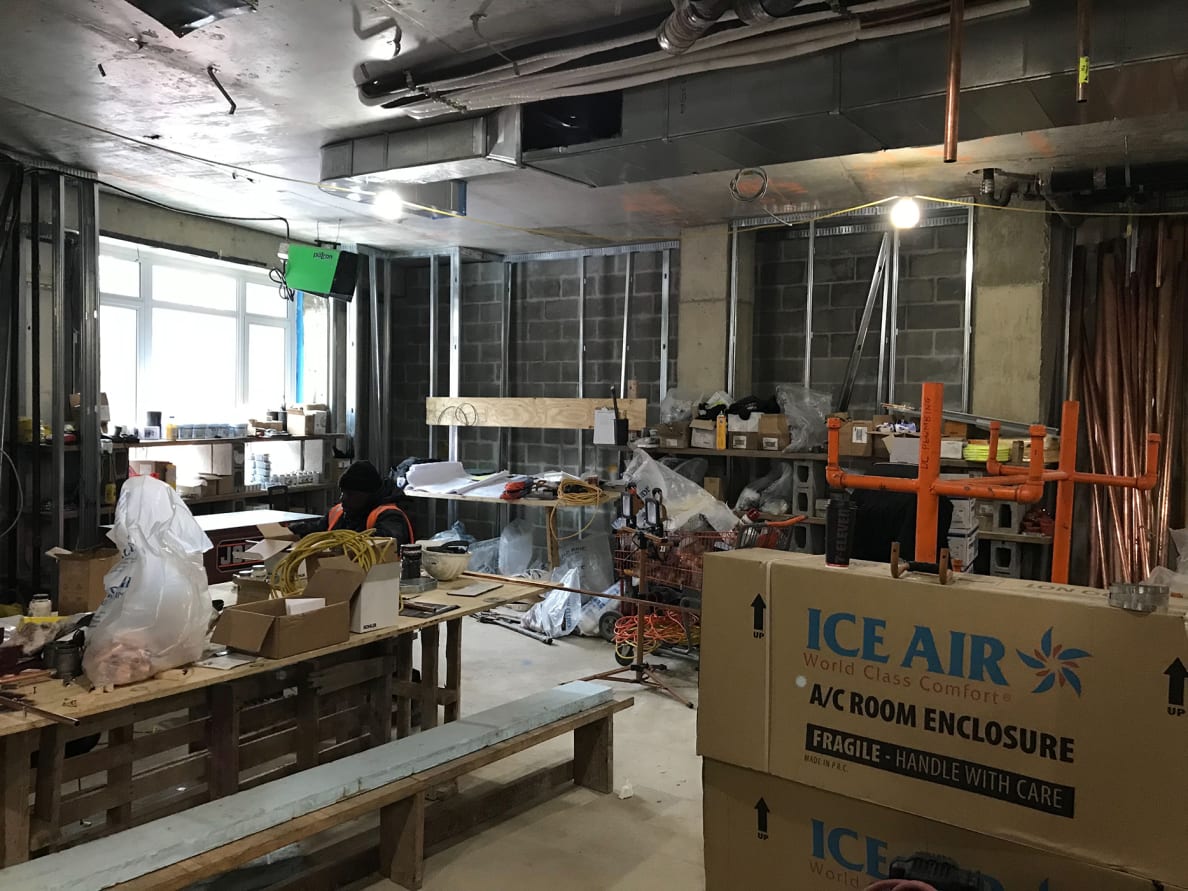Mar 11, 2019
The Daily Beast – ‘We Want To Live, Not Hide’: Inside New York City’s First LGBT Elder Housing Project
This summer, coinciding with the 50th anniversary of the Stonewall Riots, New York City’s first ever LGBT elder public housing project will open. Tim Teeman got an early tour.
Tim Teeman
03.08.19 10:05 PM ET
Construction workers have a tradition. When “topping out” a building, putting the final beam or equivalent in place, they typically plant an American flag on the property’s roof. Here, flapping in the cold winter wind on the roof of a history-making building in Fort Greene, Brooklyn, the Stars and Stripes has been joined by a rainbow flag.
When it opens in the late summer the 145-unit Ingersoll Senior Residences (ISR) will be New York City’s first affordable LGBT-welcoming senior housing development. Its first residents will move in around the same time as the 50th anniversary of the Stonewall Riots, which happened within their lifetimes and which some remember very vividly. It will also be the largest such residence in the United States.

The Stars and Stripes and rainbow flags atop the Ingersoll Senior Residences in Fort Greene, Brooklyn. Credit: Tim Teeman/The Daily Beast
Ingersoll will be joined in early 2020 by a second 82-unit residence for LGBT elders opening in Crotona Park North (CPN) in the Bronx.
A planning controversy surrounds the development of a third LGBT elder-focused property, Haven Green, in Lower Manhattan, which The Daily Beast will be reporting on separately.
Both properties are backed by SAGE, the country’s oldest and largest LGBT elder advocacy organization founded in 1978. They will have centers on their ground floors with services, advice, and activities for residents aged 62 and older.
The ‘Stonewall 50’ generation in New York City will finally have somewhere they can call a residential home of their own. Similar developments already exist in Los Angeles, Philadelphia, Chicago, and Minneapolis. New York City, for once, is not setting the pace, but playing catch-up.
The application process for Ingersoll will begin soon, with “a vigorous interview process” to follow, according to a SAGE spokesperson.
SAGE said it has a list of nearly 2,000 people interested in both of the housing developments. All must apply during the application period, and the application will be open to all age- and income-eligible people.
The level of interest, SAGE said, illustrated the “vital” need for such housing, as well as the issues facing many LGBT elders wherever they are living.
“Senior LGBT New Yorkers deserve to live their best lives, and they should be able to live happily and freely in an environment where they feel comfortable and fits their needs,” Speaker of the City Council Corey Johnson told The Daily Beast. “But most of all, LGBT seniors need to live somewhere affordable.
“I am so grateful to SAGE, a wonderful organization I have had the pleasure of working with over the years for their efforts in bringing LGBT senior affordable housing to Brooklyn and the Bronx. I thank SAGE for always looking out for LGBT seniors, and I hope to see more of these housing units so we can help as many New Yorkers as possible.”

Cheryl George, a 67-year-old lesbian, has applied for an apartment in one of the properties. Following the death of her partner, George has been living with her 44-year-old daughter on Staten Island since November 2012.
“People need their space. Everybody should have their space. I need my space, my daughter needs her space. In order for you to get good housing in New York, you need money, and I don’t see a lot of older LGBT people having a great deal of money unless they hit the stock market at the perfect time.”
SAGE emphasizes that no resident will pay more than approximately one-third of their income for rent. Income ceilings will be slightly different in each building. There will be preferences for current New York City Housing Authority (NYCHA) residents and those on the waiting list for NYCHA or Section 8 housing. The New York City Department of Housing Preservation & Development (HPD) is another partner in the project.
Mayor Bill De Blasio did not return The Daily Beast’s requests for comment about how he felt about this moment in NYC’s LGBT history, and the housing needs of LGBT elders in the city.
Instead, an HPD spokesperson sent this statement: “This administration is deeply committed to partnering with community-based organizations like SAGE to not just create quality, affordable housing for our city’s seniors, but to provide supportive services and a safe space for LGBT seniors. We look forward to continuing our partnership with SAGE and other allies to serve the needs of the aging LGBT community.”
Both residences—Ingersoll’s developer is BFC Partners, while Crotona’s is Help USA—are already over-subscribed with applicants. This is revealing in itself. A 2014 report by the Equal Rights Center found nearly half (48 percent) of same-sex LGBT older couples applying for senior housing were subjected to discrimination. Studies also show that 25 percent of transgender older adults experience housing discrimination on the basis of their gender identities.
After living their lives “out,” many older LGBTs who are widowed or alone, and not as mobile as they once were, often have to re-closet themselves because of hostile neighbors, or residents and members of staff of the senior living facilities they live within. Many, having lived vital, busy and loving lives, describe living later years of fear and isolation.
Barbara Police, a 70-year-old SAGE services user of nearly 40 years standing, said: “I have seen more people than ever in the last couple of years, young and old, coming to SAGE that have no place to live. If they go to shelters they’re the biggest target because they’re gay or lesbian or transgender. There’s rape or beatings, their property is stolen. They want to be able live openly, and not have to hide.”
Michael Adams, chief executive officer of SAGE, told The Daily Beast: “What we hear over and over again from our constituents is where they feel most uncomfortable is where they live. That shouldn’t be, and that, in a nutshell, is why we see this housing as so important.”
Adams said that discrimination can occur in many different ways. LGBT elders apply for public housing and are told no housing is available when there is; or they are asked to pay much higher monthly rents than their straight counterparts; or must fulfill more onerous application processes than non-LGBT older adults.
“Sometimes bigoted neighbors make life so difficult for openly gay elders that they then feel compelled to hide that they are LGBT in order to feel safe and not mistreated where they live, whether that is in senior housing or an elder care facility. It is tragic that so many older LGBT people feel they have to go back into the closet.”
They re-closet themselves by hiding photographs, books, magazines, anything that shows they are LGBT.
“When people come to SAGE they feel like they’re coming home and can be themselves, without worrying what anyone thinks about them,” said Adams. “Then they have to go ‘home’ again where they can’t be themselves. These new residential buildings are an environment where no one has to hide who they are to feel safe and welcome.”
SAGE, Adams said, also provided training and guidance to staff in existing housing projects and residential facilities aimed at raising awareness about the needs of LGBT elder residents.
How LGBT Housing In NYC Came To Be
Plans for LGBT elder housing were first dreamt up by SAGE in the 1980s; Adams has a box in of yellowing papers in his office with nascent plans from that time. Ingersoll and Crotona Park North were first proposed four years ago, with ground broken on both projects 18 months ago.

Adams said the plans accelerated when Mayor De Blasio had made the provision of LGBT elder housing a specific part of his first year affordable housing plan. ISR is built on city land.
Ingersoll applicants will be considered on a ‘first come, first served’ basis. “Many of the people who apply will not get in,” said Adams. “Then our goal will be to work with them to figure out what are best alternative options are for them.”
So, will older LGBTs get to live out their Golden Girls communal-living, cheesecake-and-gossip-at-midnight fantasies in the new residences?
Public funding means certain restrictions when it comes to the size of accommodations, but there will be a premium placed, said Adams, on “social and group spaces.” The laundry at ISL is next to a day room.
The model for LGBT elder living will evolve as time goes on, he predicted, with perhaps new ways of living communally. “Who wouldn’t want to be The Golden Girls, and live in that house?” he added.
On a recent afternoon Ernie Padron, assistant director of development at BFC Partners, surveyed the shell of the 68,000-square-foot site. “As a gay man, this is an exceptionally fulfilling project to work on,” he said.
Latisha Millard-Bethea, SAGE’s director of residential services, talked about the hot meals and activities residents would enjoy. Millard-Bethea grew up nearby, and noted how much the area had changed. When she was a young girl, she wasn’t allowed in “the bad part” of Fort Greene Park, which now makes for a pretty view from many of Ingersoll’s rooms.
“It’s heartbreaking to think of older LGBT people having to go back into the closet,” said Padron. “Here, they can be themselves, and be happy. A lot of these people survived the tumultuous period of the AIDS crisis, and lost friends and partners along the way. Welcoming as I think New York City is, it’s not the same environment when you’re older. In America, age is generally a tough thing to experience, and that isolation is compounded when there are other personal identity issues. That’s why this place is fantastic.”

The planned common room next to the laundry on the second floor at the Ingersoll Senior Residences. Credit: Tim Teeman/The Daily Beast
We tour the massive ground floor, and see a sample one-bedroom apartment with views over the park. There will be three terraces on floors 2, 7, and 14, with views over the East River towards the Brooklyn Navy Yards, Brooklyn Bridge and Manhattan. 37 units will be designated for the formerly homeless.
The residences in Brooklyn and the Bronx were “good news,” said Police, “but we’ve got to have an LGBT public residence in Manhattan. The property values in Manhattan are sky high, but there has to be some rich person out there who has a few billion to make it happen. There are LGBT people in Manhattan who need homes, and single people who need homes should be treated as fairly as those with families.”
George had no idea why she had never been accepted in public housing until now, but that if she was successful in her SAGE application she would look forward to being around other LGBT elders and access LGBT-focused services.
“A lot of us don’t have a lot of income. It’s very disheartening. Another problem is that when you get older most of society forgets you even exist. But being a senior isn’t so bad, and we can offer a lot of enlightenment to younger people if they want to listen.”
Growing Older as LGBT
When George, who is black, came out aged 15, her father asked her to explain “why I wanted to be gay. I didn’t think about how humiliating that would be. I think I cried afterwards, but it also made me think that I never wanted to subject any child of my own to having to defend what they were or wanted to do.”
For 40 years George worked as a customer service representative, bookkeeper, and did secretarial work. She endured harassment from straight neighbors, though not silently. “I don’t take any nonsense. Most straight people think you’re after them. I’m like, ‘Girl, you’ve got nothing I want.’ I would fight back and make clear, ‘Say what you say in front of me.’ I try hard not to take shit from anybody.”
For 23 years, she was married to her wife, Josette. They lived in Willowbrook, New Jersey.
After Josette died in 2011, George said, “I cried every day for six months. I sort of got myself together by going through the motions, mostly in a fog. I often thought of committing suicide, but my daughter kept saying, ‘Don’t go nowhere, we need you here.’ I felt like my life was over. I had to get through being angry, denial, it was a really rough time. I wouldn’t eat, I wouldn’t do anything. I would go to work, do my job, but not talk to anyone. My friends left messages, but I wasn’t in the mood to talk to other people.”
Living with her daughter and grandchildren has been restorative, and now George needs “a new chapter.” Warm and funny, she said she was “talking back and forth, entertaining, not dating” three women now, and was training to be an advocate for others in need, LGBT and not LGBT. “I want people who feel bad to know they don’t have to, and to know they have so much of life left to live,” she said. “I hope the experience of living with LGBT people is that I am able to help someone and someone can help me: a two-way street.”
She laughed, and said she also looked forward to having guests over. “Someone said to me did I want a wife, and I said, ‘Wait a minute. I don’t want to be somebody’s wife. I’ve been somebody’s wife and that’s not an easy job.’ Romance is OK. I’m still vibrant. It’s not like I just want to sit on the couch and hold hands. No, no, no.”
Yes, George said, she hopes the new residence would have elements of The Golden Girls. “I watched it. I would be Blanche. My friends always say about me, ‘There she goes again.’ I’m always into something, just like Blanche. And I will carry on doing things, until I stop. I enjoy my life. I really do. People have asked me would I choose to be gay again if I lived another life and I think I would. I enjoy every minute of my life, I have to. I made it a choice to enjoy every minute till my eyes are closed, then I won’t have to worry about it no more.”
It has been just over a year since Barbara Police, 70, lost Pat, her partner of 43 years, who died of cancer and dementia. “I’m lost,” said Police. “It’s like my right hand has gone. It’s tough. She was a very active woman. She climbed mountains and traveled around the world, and did more in her life than I did. Forty-three years is a long time to be with somebody. I miss her terribly. She was something to reckon with, let me tell you.”
Like George, Police said despite her intense grief she was determined to live: a veteran of LGBT, women’s “and every social movement you can think of,” she has been a user of SAGE’s services for almost 40 years and relishes taking part in every Pride parade standing proudly on the SAGE bus as a celebration and statement of political and cultural resistance. She has dinners with friends, and loves attending intergenerational groups, such as a recent one where she and a group of young people discussed the word “queer.”
“To younger people I say, ‘Stand your ground. Do what you believe in. Stick to it,’” said Police. “To older LGBT people, I say, ‘Reach out more. Don’t isolate yourselves.’ We went through hell to get to this point, and now the LGBT community has to stick together. Under Trump and Pence, we are in dangerous times.”
Now suffering from macular degeneration, Police lives in blind-specialized residential accommodation in New York City’s Chelsea. But she recalled the homophobia she and Pat once endured living on Staten Island in the early 1980s, when their front door was sprayed with abusive, red-paint graffiti (“Lesbian Go Home”), their car was egged and vandalized, and they received verbal harassment out shopping. Each woman was frightened for the other’s safety, and they eventually moved back to Manhattan.
“It was one of the worst experiences of my life. It scared the poop out of me,” said Police. “I thought, ‘I was was born and raised in Greenwich Village, and now I have to put up with this nonsense.’”
As a younger woman in the 1960s and 70s, George recalled experiencing both racism and homophobia on the streets, feeling “pointed out” by those who queried whether black gay people could exist.
“What I believe in is giving everybody the same respect I expect,” said George. “If they can’t do that I can walk away.”
“Being gay never stopped me from being the loving parent I was,” she added. “When people asked my daughter if she knew her mother way, she’d say ‘yeah. It’s not a choice. She still loves me. She feeds me.’”
Younger LGBT people should talk to LGBT elders, she said. “They have jewels you never even thought about. I wish I’d have known I could have spoken to them. I did speak to one woman in her eighties, a long time ago, who told me about having children, and going with women and men. But talk to them, have them pass on what they know. It will help give you, as a younger person, a stronger foundation.”
Stonewall: We Were There
George recalled being 18 when the Stonewall Riots happened in June 1969. She remembered how Greenwich Village felt in the aftermath.
“Usually the Village was full of life and fun. But afterwards I remember everybody was afraid to do anything because you couldn’t be who and what you wanted to be. You would walk down the street and wonder who was watching you. You didn’t know if the cops were coming. Everyone was sneaking into corners. You were worried in case somebody was beaten up for being gay. A lot of people were frightened. It was confusing.”
But things changed quickly, George recalled, laughing as she remembered the lesbian bars and hangouts she enjoyed like The Duchess, Pandora’s Box, and the “bougier” Sahara uptown where you had to dress up.
Police recalled the first night of the Stonewall Riots. Her parents lived a few blocks away on Charles Street. She recalled where the Duplex is now was the site of the Village Voice newspaper.
Near the Stonewall, some friends told her there was a “big war with the cops, bull-dykes and other people. I saw Marsha (P.) Johnson with her mouth open, so the cops were going after her. A lot of people were getting hit, then I heard the police horses coming down the block and it got even more scary.” Her father said for Police and her friends to go to the house, where her mother “had made a small triage in the kitchen to treat everybody’s bumps and scrapes,” and where her parents encouraged everyone to call their loved ones.
Her parents and grandma (who played cards with two of Police’s gay male friends) had always loved all of Police’s friends. “To my family, as long as you were happy and healthy, that was the main thing. They were a different kind of family, not perfect, but they accepted everybody.”
Police had been 11, when she had told her parents, “Ma, dad, I got to tell you something. Ma, I’m a lesbian.” Police paused in the retelling. “My father looked at my mother and said, ‘Rose, what are we gonna eat tonight?’ I said, ‘Ma, I just told you… ’ And she said, ‘Oh come on, we knew a long time ago. Let’s eat.’”
Fate brought her mother to a bed on an AIDS ward in 1985, when she herself was very sick. Her gay friends, now severely ill with the disease, looked up, Police recalled, and said, “Rosemary’s here.”
“My mom died that night, and some of her friends did too,’ Police recalled. “So Stonewall has a special meaning, not just because of the Riots, but also because of mom and dad and grandma, and how everybody close to me accepted me being gay.
Police recalled the first Pride march a year after the Riots, and how big and commercial (to its detriment, she felt) it became.
Now, Police stands on the SAGE bus at the front of the parade and waves, and accepts flowers from “the young ones. At my age I want to help the kids get things going and keep things going, politically. My message is to stop going on social media, get on the streets, make it a grassroots thing, get out and talk to people. Don’t stay behind a computer and phone. Look someone in the face, shake their hand and hug them. Make them understand where we came from, and how we have to stick together more than ever.”